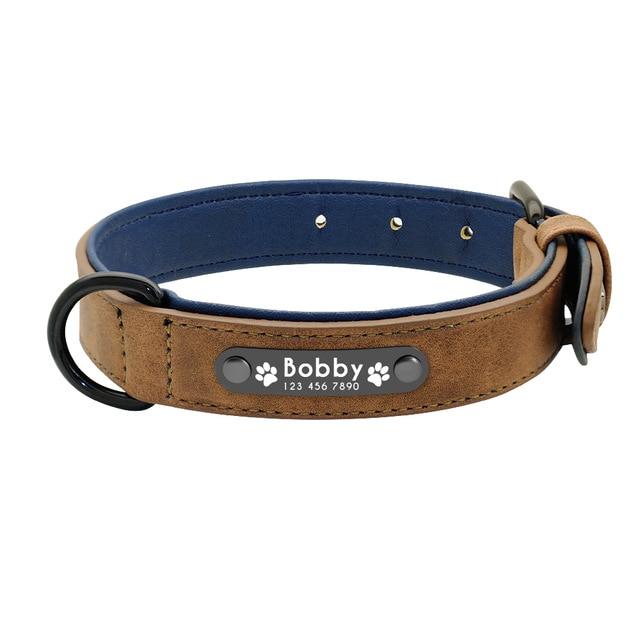Owning a Frenchie is like raising a toddler with muscles, sass, and a stubborn streak. They’re cute, compact, and full of attitude… and that makes choosing the right gear way more important than people think. You’re not just picking between a collar or a harness; you’re choosing your Frenchie’s comfort, safety, and breathing room.
With their short snouts, chunky necks, and tendency to pull like they’re auditioning for a sled team, French Bulldogs aren't exactly built for your average dog gear. The wrong choice could mean choking, slipping out mid-walk, or worse, vet visits you didn’t plan for.
So, what should you use? A sleek collar that keeps their ID handy, or a harness that gives you control and keeps their airways clear?
This post highlights when you should put on a collar or harness, considering different situations.
When You Should Put a Collar On a French Bulldog
Collars have long been the traditional choice for dogs, and they can still be used for French Bulldogs, but selectively and carefully.
1. A Quick Means of Identification
It would help if you used collars when you want to identify your French Bulldog quickly. Collars function as a quick means to identify your Frenchie if you are going around many other French Bulldogs. They help to hold your dog tag effectively.
2. Works well for Young Puppies & Well-Trained Frenchie
Also, you should use your dog tag if your Frenchie is a young puppy. Many Frenchie do not like harnesses because they are usually not comfortable when they are put on. Collars will be the best fit for your Frenchie puppy because only the neck is tied.
Use only collars when you have a well-trained Frenchie who will not pull. This is especially so when you are taking short walks. But harnesses are for French Bulldogs that can pull when going on walks.
Must Consider the Following Concerns
- Poorly fitted collars can be a safety risk. French Bulldogs have thick necks and relatively small heads, making it easy for them to slip out of a loose collar.
- If your dog pulls or lunges, the pressure on the neck can cause tracheal damage, thyroid irritation, or even choking.
- Some people have noticed their dogs gasping or choking when a collar was kept on for hours or fit too snug.
French Bulldogs are even more at risk. Their squished little faces and narrow airways already make breathing tough. Adding a collar during walks or exercise just puts more strain on them. It’s not worth the risk.
Learn in detail about the different facts of French Bulldogs.
When to Use a Harness for a French Bulldog
French Bulldogs do better with harnesses. It’s not just about comfort, it’s about their health. These dogs have short snouts, making them part of the brachycephalic group. That means breathing can be a challenge, especially under pressure around the neck.
A collar can put too much strain on their windpipe; that’s not safe, especially when they pull or get excited. Harnesses help avoid that. You’ll find them most useful during walks, training your Frenchie, or even casual outdoor time. A harness is mostly useful in the following situations:
1. Long Walks or Outdoor Activities
Frenchie gets excited easily, in excitement, they tug on walks, chasing smells or sounds. A collar tightens around the neck, but a harness doesn’t. It spreads out the pull across the chest, giving better control and protecting their fragile throat from harm, good for evening walks and safe outdoor visits.
2. Training Sessions
A young or untrained French Bulldog can be full of surprises, pulling on the leash, jumping at random, or running off suddenly. A good harness keeps things safer. It gives you the upper hand without hurting your pup and helps you train them with more care.
3. Safety On the Go
Harnesses are also ideal for car rides, especially when used with a seatbelt attachment. They reduce the risk of injury during sudden stops and keep your dog securely in place.
Learn safety tips to travel with your French Bulldog.
A Few Things to Watch Out For
Sometimes, harnesses can cause sore spots. You’ll usually notice it under their legs or around the armpits if they wear it for too long. That’s why it’s smart to use both a collar and a harness; it just depends on how long they’ll have it on and what you’re doing that day.
If the harness isn’t fitted the right way, it can dig into the chest. This happens a lot with front-clip types. For your Frenchie, a harness that clips on the back is the safer choice for everyday walks. It’s easier on their body and helps them breathe without strain.
Why Most Pet Parents Prefer Both?
Many Frenchie parents find the combination of a simple flat collar and a well-fitted, breathable harness to be the ideal setup. The collar stays on for everyday use, while the harness is put on only when it’s walk time or when you’re heading out.
This system makes gear-wearing less overwhelming for your dog and more functional for you. Plus, it helps extend the life of both items, less wear and tear overall.
Tips for Choosing the Right Gear For Your French Bulldog
Your Frenchie’s walking gear should suit their anatomy, activity level, and comfort. Here’s what to keep in mind when choosing between or investing in both:
1. Frenchie’s Personality
French Bulldogs have bold personalities. Some are mellow couch potatoes, while others are high-energy explorers. Choose gear based on your dog’s behavior:
- Calm walker? A lightweight harness or flat collar may be sufficient for short outings.
- Puller or leash-reactive? Go with a front-clip harness for control and training support.
- Sensitive or anxious pup? Look for padded, breathable options that won’t irritate or overheat.
2. Measure for a Harness or Collar
Fit is everything. Ill-fitting gear can rub, chafe, or cause injury.
Here’s how to measure:
- For collars: Measure around the base of the neck, where the collar would sit. Add two fingers under the tape for slack.
- For harnesses: Measure both the neck and the widest part of the chest (just behind the front legs).
Most gear will include sizing charts. When in doubt, size up; a harness that's too tight will restrict movement and breathing.
3. Material Considerations (Breathable, Padded, Lightweight)
Your Frenchie is prone to overheating, so choose materials carefully:
- Breathable mesh: Great for summer months or long walks.
- Neoprene padding: Adds comfort and reduces rubbing.
- Nylon webbing: Durable and often lightweight.
- Reflective stitching: Ideal for nighttime safety.
Avoid cheap plastic or stiff leather, which can irritate your dog’s skin and trap heat.
4. Adjustability Is Key
French Bulldogs come in various shapes; some are broader, others leaner, so gear that fits one Frenchie may not suit another.
Look for:
- Multiple adjustment points (neck, chest, and girth).
- Quick-release buckles for easy on/off.
- Elasticity or stretch panels for a snug yet flexible fit.
Try the “two-finger rule”: You should be able to slide two fingers between
5. Always Check for Rubbing, Chafing, or Discomfort
Even the best gear can cause problems if worn incorrectly or for too long. Inspect daily for redness, hair loss, or skin irritation.
Watch behavior, scratching, licking, or trying to remove the harness = discomfort.
Adjust to the dogs’ body sizes that change over time (especially growing pups). Don’t leave harnesses on indoors unless necessary. Let your Frenchie rest gear-free.
Bottom Line
Now that you understand why you use a collar vs. a harness, you should know that it is better to have both around and use them for your Frenchie, depending on the need.
Disclaimer: This post includes affiliate links. If you buy through these links, we may earn a small commission, without any extra cost to you. Thanks for your support!










